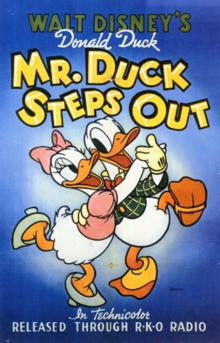
Daisy Duck is a cartoon character created by The Walt Disney Company. As the girlfriend of Donald Duck, she is an anthropomorphic white duck that has large eyelashes and ruffled tail feathers around her lowest region to suggest a skirt. She is often seen wearing a hair bow, blouse, and heeled shoes. Daisy was introduced in the short film Mr. Duck Steps Out (1940) and was incorporated into Donald's comic stories several months later. Carl Barks, the screenwriter and lead storyboard artist for the film, was inspired by the 1937 short, Don Donald, that featured a Latin character named Donna Duck, to revive the concept of a female counterpart for Donald.

Huey, Dewey, and Louie are triplet cartoon characters created by storyboard artist (screenwriter) Carl Barks for The Walt Disney Company from an idea proposed by cartoonist Al Taliaferro and are the nephews of Donald Duck and the grand-nephews of Scrooge McDuck. Like their maternal uncles, the brothers are anthropomorphic white ducks with yellow-orange bills and feet. The boys are sometimes distinguished by the color of their shirts and baseball caps. They featured in many Donald Duck animated shorts and in the television show DuckTales and its reboot, but comics remain their primary medium.

Mickey Mouse Works is an American animated television series produced by Walt Disney Television Animation featuring Mickey Mouse and his friends in a series of animated shorts. The first Disney television animated series to be produced in widescreen high definition, it is formatted as a variety show, with skits starring Mickey Mouse, Minnie Mouse, Donald Duck, Daisy Duck, Goofy, Pluto and Ludwig Von Drake while Horace Horsecollar, Clarabelle Cow, Morty and Ferdie Fieldmouse, Huey, Dewey and Louie, Chip 'n' Dale, Scrooge McDuck, Pete, Humphrey the Bear, J. Audubon Woodlore, Dinah the Dachshund, Butch the Bulldog, Mortimer Mouse, José Carioca, and Clara Cluck appear as supporting or minor characters. Musical themes for each character were composed by Stephen James Taylor with a live 12-piece band and extensive use of the fretless guitar to which the music of the series was nominated for an Annie Award in both 1999 and 2001. Most of the shorts from the series were later used in House of Mouse.

Quack Pack is an American animated sitcom produced by Walt Disney Television Animation, featuring Donald Duck and his nephews. The show debuted on September 3, 1996, as a part of the "Disney Afternoon" programming block, following the success of Goof Troop. The series ran for one season with 39 episodes.

Trick or Treat is a 1952 animated short film produced by Walt Disney Productions and released by RKO Radio Pictures. The cartoon, which takes place on Halloween night, follows a series of pranks between Donald Duck and his nephews with Witch Hazel. The film was directed by Jack Hannah and features the voices of Clarence Nash as Donald and his nephews, and June Foray as Hazel.

Donald's Nephews is a 1938 Donald Duck animated cartoon which features Donald being visited by his three nephews, Huey, Dewey, and Louie. This cartoon is Huey, Dewey, and Louie's first appearance in animation. Al Taliaferro, the artist for the Silly Symphony comic strip, proposed the idea for the film, so that the studio would have duck counterparts to Morty and Ferdie Fieldmouse, the nephews of Mickey Mouse. The Walt Disney Productions Story Dept. on February 5, 1937 sent Taliaferro a memo recognizing him as the source of the idea for the planned short.
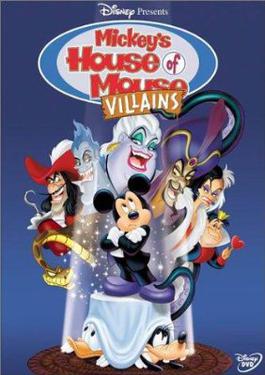
Mickey's House of Villains is a 2002 American direct-to-video animated comedy-horror film produced by Walt Disney Television Animation. It is based on the animated television series House of Mouse and serves as a stand-alone sequel to the direct-to-video animated film Mickey's Magical Christmas: Snowed in at the House of Mouse, starring Mickey Mouse, Donald Duck, Minnie Mouse, Goofy, Daisy Duck, and Disney Villains that appeared in past Disney productions. It was released on both VHS and DVD by Walt Disney Home Entertainment on September 3, 2002.
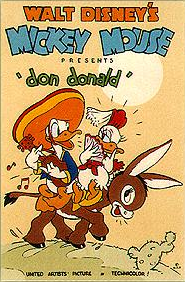
Don Donald is a 1937 American animated short film produced by Walt Disney Productions and released by United Artists. The cartoon follows Donald Duck attempting to woo a female Mexican duck named Donna. It was directed by Ben Sharpsteen and features music by Paul J. Smith which was adapted from the Mexican folk songs "Cielito Lindo" and "Jarabe Tapatío". Clarence Nash voiced both Donald and Donna.

Good Scouts is a 1938 American animated short film produced by Walt Disney Productions and released by RKO Radio Pictures. The cartoon follows Donald Duck leading his nephews Huey, Dewey, and Louie on a scouting trip through the wilderness. It was directed by Jack King and features Clarence Nash as Donald and the three nephews.

Donald's Golf Game is a cartoon released by the Walt Disney Company in 1938. Donald falters on the fairway while his caddies Huey, Dewey, and Louie all try to "tee" him off, with a grasshopper and a bag of trick clubs.

Don's Fountain of Youth is a 1953 American animated short film by Walt Disney Productions featuring Donald Duck.
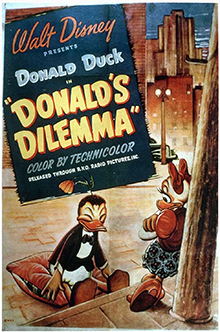
Donald's Dilemma is a Walt Disney Studios animated cartoon directed by Jack King and starring Donald and Daisy Duck. It was originally released on July 11, 1947 in the United States. The title of this short is somewhat of a misnomer. Although Donald is the official headliner for this cartoon, Daisy is the actual protagonist. The dilemma of the title is actually offered to her, not to Donald.
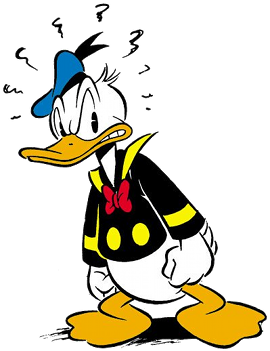
Donald Duck is a cartoon character created by The Walt Disney Company. Donald is an anthropomorphic white duck with a yellow-orange bill, legs, and feet. He typically wears a sailor shirt and cap with a bow tie. Donald is known for his semi-intelligible speech and his mischievous, temperamental, and pompous personality. Along with his friend Mickey Mouse, Donald was included in TV Guide's list of the 50 greatest cartoon characters of all time in 2002, and has earned a star on the Hollywood Walk of Fame. He has appeared in more films than any other Disney character.

Donald Duck and the Gorilla is a Donald Duck short adventure horror monster film which was originally released in 1944. It stars Donald Duck along with his three nephews; Huey, Dewey and Louie and Ajax, the killer gorilla. The 1930 Mickey Mouse cartoon The Gorilla Mystery has a similar plot involving a gorilla named Beppo who captures Minnie Mouse.
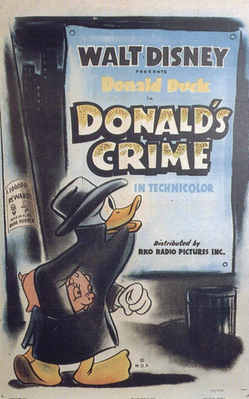
Donald's Crime is a 1945 American animated short film produced by Walt Disney Productions and released by RKO Radio Pictures. The cartoon, which parodies film noir crime dramas of the time, follows Donald Duck as he struggles with guilt after stealing $1.25 from his nephews. The film was directed by Jack King and features original music by Edward H. Plumb. The voice cast includes Clarence Nash as Donald, Huey, Dewey, and Louie, Ruth Clifford as Daisy Duck, and Harry E. Lang as the off-stage voice of Donald's conscience. This was Blondell's first performance as Daisy and marks the debut of the character's "normal" voice. Previously in Mr. Duck Steps Out, Daisy had been voiced by Nash using a voice similar to Donald's.

Home Defense is a 1943 animated short film produced by Walt Disney Productions and distributed by RKO Radio Pictures. The film shows Donald Duck and his three nephews Huey, Dewey, and Louie serving as civilian aircraft spotters during World War II. The film was directed by Jack King, Clarence Nash voices the characters.

Soup's On is a 1948 Donald Duck animated short film directed by Jack Hannah, produced in Technicolor by Walt Disney Productions and released to theaters by RKO Radio Pictures.

Straight Shooters is a 1947 American animated short film directed by Jack Hannah and produced by Walt Disney, featuring Donald Duck.

Donald's Diary is a Donald Duck short film which was produced in Technicolor and released February 13, 1954 by RKO Radio Pictures.

Donald Duck is a series of American animated comedy short films produced by Walt Disney Productions. The series started in 1937 with Donald's Ostrich and ended in 1961 with The Litterbug. The series, a spin-off of the Mickey Mouse film series, stars the titular character Donald Duck, in addition to having recurring appearances by previously known characters such as Pluto and Pete, and also introduced well-known characters such as Donald's nephews Huey, Dewey and Louie and Donald's love interest Daisy Duck, as well as Donald's recurring rivals Chip 'n' Dale under their names.
